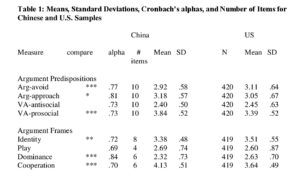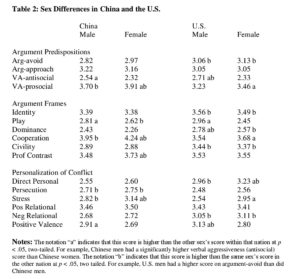ISSA Proceedings 2014 ~ Chinese Understanding Of Interpersonal Arguing: A Cross-Cultural Analysis
No comments yetAbstract: China has a longstanding tradition of stressing the values of harmony and coherence, and Chinese society has always been alleged to be a group where conflict avoidance is viewed more positively than direct confrontation and argumentation. In order to evaluate the validity of this claim, this paper sketches Chinese people’s feelings and understandings of interpersonal arguing by reporting results of a data collection in China, using measures of argumentativeness, verbal aggressiveness, argument frames, and personalization of conflict. Chinese and U.S. data differed in complex ways, but did not show Chinese respondents to be more avoidant. The Chinese correlations among variables were a reasonable match to expectations based on Western argumentation theories. The paper offers evidence that Chinese respondents had a more sophisticated understanding of interpersonal arguing than their U.S. counterparts, and were more sensitive to the constructive possibilities of face-to-face disagreement.
Keywords: argument predispositions, China, confrontation, interpersonal arguing
1. Introduction: Chinese orientations to interpersonal arguing
Most of the existing literature on argumentation and communication studies suggests that the Chinese culture has long stressed the values of harmony, coherence, and holism, implying that Chinese people would prefer non-confrontational, non-argumentative, and conflict avoidance approaches over direct argumentation and confrontation in their social lives (Jensen, 1987, Leung, 1988; 1997; Lin, Zhao, & Zhao, 2010; Oetzel & Ting-Toomey, 2003; Oetzel et al, 2001; Triandis, 1995). Accordingly, Chinese society has always been regarded as a group where conflict avoidance is viewed more positively than direct confrontation and argumentation, and Chinese people’s understanding of, and attitudes towards, interpersonal arguing have been supposed to differ significantly from those of Western people, whose culture has appreciated, from its very beginning, the importance of argumentative practices.
Moreover, it has also been argued by many scholars that, within Chinese social-cultural tradition, there is indeed a lack of argumentation and debate, a deprecation of speeches, and even a disinterest in logic (Becker, 1986; Kennedy, 1980). This longstanding tradition has not only contributed to a deficiency of argumentation studies in ancient China, but has also shaped in an important way the Chinese people’s orientations to interpersonal arguing behaviors in modern times (Oliver, 1971; Kincaid, 1987). In the last decades, a considerable amount of work has been done to argue against the absence of argumentation and its study in ancient China (Garrett, 1993; Jensen, 1992; Lu & Frank 1993), but there seem to be few studies that examine what the modern Chinese people’s orientations to interpersonal arguing really are, and whether they do differ from those of Westerners in a significant way. The purpose of this paper is to address these last two questions with empirical findings. In what follows, we first explain the instruments we have used to sketch understanding of interpersonal arguing, then we present the results of our study and make comparisons between the Chinese and the U.S. data, and finally we end with some discussion concerning Chinese orientations to confrontation and argumentation.
2. Sketching Chinese people’s understanding of interpersonal arguing
There are quite a few possible approaches to providing an empirical summary of Chinese people’s views on arguing, and in fact we have already addressed this topic in a different way (Xie, Shi, Evans & Hample, 2013). However, this paper is also part of a systematic cross-cultural project in which we are trying to compare different nations and cultures on the same instruments. The project’s intention is to establish some general findings and comparisons that can be explored further with other methods and aims. To that end, we have decided to make use of several instruments that we believe have clear implications for most arguing behaviors and orientations. These instruments have all been developed in the United States, which immediately raises questions about their relevance to other cultures. However, even the finding that these concepts lack importance elsewhere in the world would be substantially informative.
2.1 Argumentativeness and verbal aggressiveness
The first instruments bear on people’s motivations and orientations to interpersonal arguing. These are argumentativeness (Infante & Rancer, 1982) and verbal aggressiveness (Infante & Wigley, 1986). These both represent approach/avoid motivations that are relevant to arguing, but they differ in their motivational targets. Argumentativeness is the predisposition to engage or attack the other person’s evidence, reasoning, or position. Verbal aggressiveness is the predisposition to attack the other person’s character, background, or identity. Being argumentative is constructive and has a host of positive consequences, but being verbally aggressive is destructive and is corrosive to relationships (Rancer & Avtgis, 2006).
Some prior research has applied these concepts in China (or, in several cases, Taiwan). Only a little of this work bears very directly on the present project, but it may be worthwhile to summarize it all in one place. Lin, Rancer, and Kong (2007), using Chinese-language materials, found that Chinese college students’ argumentativeness scores were associated with communication practices in their families of origin. Students with high argumentativeness scores tended to come from consensual or pluralistic families rather than protective or lassiez-faire ones. Consensual and pluralistic families have in common that they emphasize conceptual development in their conversations, whereas protective families cut off substantive discussion to prevent stress and lassiez-faire families do not pursue either conceptual or social goals. Yeh and Chen (2004), also using non-English materials, compared the argumentativeness of residents of mainland China, Taiwan, and Hong Kong. They discovered that argumentativeness was positively associated with assertiveness and independent self-construals, and was negatively correlated to interdependent self-construals and social traditionalism. Students living in mainland China had the highest argument-approach scores compared to students living in Taiwan or Hong Kong, and Taiwanese students had the lowest argument-avoid results.
Bresnahan, Shearman, Lee, Ohashi, and Mosher (2002) found that in China, Japan, and the U.S., men had higher argumentativeness and verbal aggressiveness scores than women. Chinese participants had higher verbal aggressiveness scores than Japanese or American respondents. The researchers also discovered that U.S. participants responded more aggressively to a personal complaint than people from China or Japan. Hsu (2007) compared U.S. and Taiwanese undergraduates, and found Americans to be higher in argumentativeness. Hsu found no sex difference among Taiwanese respondents on the argumentativeness measure. Hsu also compared English- and Chinese-language versions of the instrument for Taiwanese respondents and found no mean differences and a correlation of .79 between them.
Considered together these results are rather mixed, mainly due to the differences between mainland and Taiwanese samples, which are hard to interpret in the present context. However, the results are theoretically sensible (see Rancer & Avtgis, 2006), and afford evidence that the argumentativeness and verbal aggressiveness constructs and measures have validity in China. The current project will re-test some of the inconsistent findings, particularly the male-female differences and the comparisons of U.S. and Chinese college students.
2.2 Argument frames
Argument frames refer to the expectations and understandings that people have for interpersonal arguing (Hample, 2003). These scales were developed to provide a summary answer to the question, “What do people think they are doing when they are arguing?” The frames fall into three categories, which are held to be in order of argumentative sophistication. The most basic group consists of the primary goals for arguing. Those goals are utility (obtaining some benefit), displaying identity, asserting dominance, and play. All of these are self-centered motivations that treat the other person as no more than a means to achieving one’s own objectives. The second group, in contrast, takes the other arguer into account in a more genuine way. These frames include blurting (non-blurters adapt to the other person), cooperation (as opposed to competition), and civility. The final group of frames has only one measure, called professional contrast. This lists a number of paired descriptors that argumentation professionals have one view about and many ordinary arguers have the opposite (e.g., is argument an alternative to violence, or an invitation to it?). High scores on this scale indicate agreement with the professionals. Development of the measuring scales has taken place over the years (Hample, Richards, & Skubisz, 2013; Hample, Warner, & Young, 2009).
Except for some unreported work in our own multinational project, we are unaware of these measures having been used in countries or cultures outside the U.S. However, they should serve their summarizing function and provide a useful platform for comparing U.S. and Chinese orientations to interpersonal arguing.
2.3 Taking conflict personally
The final set of topics investigated here concerns the personalization of conflict (Hample & Cionea, 2010; Hample & Dallinger, 1995). People vary in the degree to which they take conflict personally (TCP). Again, a battery of scales is employed to measure this set of predispositions. Direct personalization is the most immediate measure of a person’s inclination to take conflicts personally. Stress reactions include both physical and psychological stress experiences connected to conflict. Persecution feelings refer to the belief that other people are participating in the conflict in order to victimize the respondent, rather than to settle any substantive issue. Positive and negative relational effects measure people’s estimates that conflicts can enhance or damage personal and workplace relationships. Finally, valence is a general summary of whether the respondent enjoys or dislikes interpersonal conflict.
The TCP instruments have been applied outside the U.S. (Avtgis & Rancer, 2004), but not in China to our knowledge. The Bresnahan et al. (2002) finding that Americans responded more aggressively to complaints than Chinese respondents did may be helpful, although the relationships between TCP and aggression have proved to be complex (Hample & Cionea, 2010). Comparing U.S. and Chinese respondents on the TCP measures should enhance our understanding of how arguments are approached and conceptualized in these nations because interpersonal arguments often involve disagreements and goal incompatibility.
2.4 Summarizing argument orientations
Collecting data on all these instruments at once permits more information than if they were explored in separate studies. We intend to examine two sorts of information: means and correlations. Whether college students from the two countries have similar mean scores will be informative, and this analysis may permit us to say that students from one country are higher or lower on some particular measure. But a more theoretically provocative question is whether the instruments have the same dynamic interconnections in both countries. Do the measures have the same connections to one another in the U.S. and China? It is possible that national means could be comparable but the correlations could differ, or the reverse. By examining both sorts of outcomes, we hope to begin a comparative sketch of U.S. and Chinese arguing profiles.
3. Method
3.1 Respondents
Respondents were 235 first year students at two Chinese universities, Sun Yat-sen University (N = 212, 90% of the sample) and South China Normal University (N = 23, 10% of the sample). Both universities are comprehensive multi-disciplinary institutions, located in Guangzhou, the biggest city in the Southern part of mainland China. Sun Yat-sen University is the best university in this area, ranking as one of the top ten universities in mainland China. Its enrolled students are normally elites in their generation. All the respondents were native Chinese, approximately a half of them were local (i.e. from Guangdong province), and the other half were from different parts throughout China. 86 of the respondents were men (37%) and 149 (63%) were women, and they were all about the age of 19. Respondents at Sun Yat-sen University majored in Law, and those at South China Normal University were Education majors.
3.2 Procedures
Survey instruments were in Mandarin, using the Chinese-language versions published in Xie, Shi, Evans & Hample (2013). Data were collected in classes. Completing a booklet typically took about half an hour.
3.3 Measures
Reliabilities, means, standard deviations and sample sizes for all measures are in Table 1.
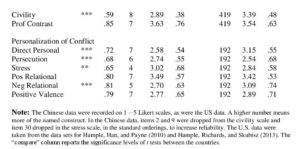
Table 1: Means, Standard Deviations, Cronbach’s alphas, and Number of Items for Chinese and U.S. Samples Note: The Chinese data were recorded on 1 – 5 Likert scales, as were the US data. A higher number means more of the named construct. In the Chinese data, items 2 and 9 were dropped from the civility scale and item 30 dropped in the stress scale, in the standard orderings, to increase reliability. The U.S. data were taken from the data sets for Hample, Han, and Payne (2010) and Hample, Richards, and Skubisz (2013). The “compare” column reports the significance levels of t tests between the countries.
* p < .05 ** p < .01 *** p < .001
Argumentativeness and verbal aggressiveness are both twenty item scales, each composed of two subscales. Argumentativeness includes argument-avoid and argument-approach. Verbal aggressiveness includes both an antisocial and a prosocial subscale. Reliabilities for all four subscales were acceptable (see Table 1).
Six of the argument frames subscales were used in the present study. Scales for blurting and utility were still under development in the U.S. at the time the current project was planned. First order frames include identity display, dominance assertion, and play. Cooperation and civility represent the second order frames. The professional contrast instrument was included, and of course reflects the third order of framing. The reliability for play was very slightly less than what was wanted, and the reliability for the civility measure was low even after two items were dropped (see Table 1).
The six Taking Conflict Personally (TCP) subscales are direct personalization, persecution feelings, stress reactions, positive relational effects, negative relational effects, and valence. One item needed to be omitted from the stress scale to increase internal consistency. Reliabilities for persecution feelings and stress reactions were a bit low, but the other instruments had acceptable Cronbach’s alphas (see Table 1).
3.4 Comparison data
U.S. data used for comparison to the present results were reported in Hample, Han, and Payne (2010) and Hample, Richards, and Skubisz (2013), and further details about the two data sets can be found in the original reports. These data were collected online from undergraduates at the University of Maryland, a large public university in the U.S. Mid-Atlantic Region. Combined sample size from the two studies was about 420 for several measures, but only 192 for the TCP instruments. These data are also summarized in Table 1.
4. Results
4.1 Sex differences
As summarized earlier, prior research has reported that men tend to have higher argumentativeness and verbal aggressiveness scores in both China and the U.S. Table 2 shows the relevant results for this study.
Notes: The notation “a” indicates that this score is higher than the other sex’s score within that nation at p < .05, two-tailed. For example, Chinese men had a significantly higher verbal aggressiveness (antisocial) score than Chinese women. The notation “b” indicates that this score is higher than the same sex’s score in the other nation at p < .05, two tailed. For example, U.S. men had a higher score on argument-avoid than did Chinese men.
Chinese men and women displayed some different patterns. Men were significantly higher in verbal aggressiveness (antisocial), interest in arguing for play, and in general valence for conflict (valence is scored so that high scores indicate positive affect). Chinese women were higher in verbal aggressiveness (prosocial), cooperative orientations to argument, professional contrast scores, and feelings of stress while engaged in conflict. The general pattern here is that, compared to Chinese women, Chinese men were more aggressive and less advanced in their understandings and expectations about interpersonal arguing. Sex differences in the U.S. are not of special interest here, except to notice that many of the same sex differences in China were also present in the U.S. data.
Same sex comparisons between the two countries are of more interest. First consider the men. Compared to U.S men, Chinese men had higher verbal aggressiveness (prosocial) scores, were more cooperatively oriented, felt more persecution in conflicts, and had greater stress reactions. U.S. men, on the other hand, were more avoidant when faced with an argument, were more antisocial, made more use of arguments to display own identity, were more oriented to domination purposes for arguing, saw arguments as more civil, took conflicts more personally, were more pessimistic about relational consequences of conflict, but enjoyed conflicts more. The pattern here is somewhat delicate, but Chinese men seemed to try to be more pleasant in argument and had markedly more stress and persecution feelings. U.S. men seemed to have a more intense ambivalence about arguing: they wanted to avoid it, but made more use of it for identity and dominance displays, worried more about negative repercussions, but took more pleasure in conflicts.
Cross-national differences also appeared for women. Chinese women, compared to those in the U.S., were more avoidant, made more use of arguing for identity and dominance displays, were more civil, took conflicts more personally, and were more pessimistic about the relational consequences of conflicts. U.S. women were more prosocial, more playful, more cooperative, more sophisticated in their understanding of the activity, and felt more persecuted and stressed by conflicts. Again, this comparative pattern is complex, but it may be that U.S. women were more engaged in arguing for both good or ill, whereas Chinese women tended to be more avoidant and personal in their arguments.
4.2 National mean differences
Table 1 displays the mean scores for both countries, along with results of significance tests between them. Compared to U.S. respondents, Chinese students had higher approach motivations, were more prosocial in their intentions, were more cooperative, felt more persecuted, and experienced more stress. Chinese respondents also were less avoidant, made less use of arguments to display identity or assert dominance, were less civil, took conflicts less personally, and were less pessimistic about the relational consequences of conflicts. This pattern is mixed. Chinese respondents were more inclined to participate in arguments, but not for every reason (e.g., they did not orient to identity functions). They reacted negatively to conflicts in some respects (persecution and stress) but not others (personalization and negative relational consequences). Chinese respondents’ politeness orientations were also mixed, compared to Americans’. Chinese students reported that they were comparatively less civil, but more cooperative and prosocial. Overall, the comparisons of Chinese and U.S. orientations show that the two nations’ students have many differences, but these do not congeal into a clear statement to the effect that one nation enjoys arguments more, avoids them more, is more polite during them, or understands them in a simple and dramatically different way.
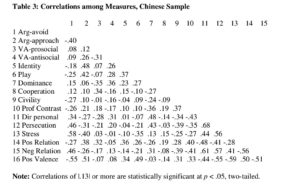
Table 3: Correlations among Measures, Chinese Sample Note: Correlations of |.13| or more are statistically significant at p < .05, two-tailed.
4.3 Dynamic associations in China
Table 3 reports correlations among the measures, restricted to the Chinese data. First, let us consider the subscales for each group of measures.
The relationships among the argumentativeness and verbal aggressiveness measures were conceptually expectable. Argument-avoid and argument-approach were correlated substantially and negatively, as were the prosocial and antisocial subscales of verbal aggressiveness. A noticeable positive correlation between argument-approach and VA-antisocial also appeared, and this matches the measures’ common status as a sort of assertiveness.
The frames measures also showed substantial associations among themselves. The first order frames (identity, play, and dominance) were all positively associated. The second-order frames, cooperation and civility, were not associated at significant levels, although both had positive connections to professional contrast scores. Conceptually, cooperation and civility ought to have been positively correlated, but the other results match theoretical understandings of the constructs.
Finally, the subscales of TCP were also intercorrelated. The measures that are sometimes collected into one measure in the U.S. (called “core TCP”) are direct personalization, persecution feelings, and stress reactions, and these three subscales were positively and very substantially associated in Table 3. The positive and negative relational consequences subscales had their expectable large negative correlation, and the negative consequences scale was directly associated with the core TCP measures. Valence had very strong correlations with the other subscales, all in the conceptually expectable directions.
Some mention should also be made of noticeably strong patterns from one scale battery to another, especially for particularly important measures. Conflict valence was strongly correlated with nearly every other measure in the study, indicating that this instrument affords very good predictions of how much a Chinese respondent will enjoy interpersonal conflicts. Another key measure is professional contrast, which summarizes the sophistication with which participants understand face-to-face arguing. Professional contrast scores were also well predicted here. Those with the most sophisticated understandings were also those with the highest scores on argument-approach, prosocial motivations, cooperativeness, civility, optimism about relational consequences, and enjoyment of conflict; these people also had the lowest scores for avoidance, antisocial motivations, dominance impulses, core TCP, and pessimism about relational consequences of interpersonal conflicts. Chinese respondents who were most eager to engage argumentatively were those who saw the identity, dominance, and play uses for arguing; who had notably low scores on the core TCP measures; who believed that conflicts improve relationships; and who enjoyed the experience of an interpersonal conflict. The most antisocially aggressive individuals in the sample were also sensitive to the identity, dominance, and play potentials for arguing; had low scores for cooperation, civility, and professional contrast; and tended to take conflict personally.
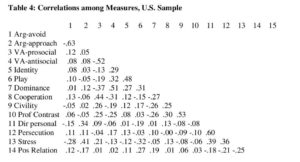 4.4 Comparisons of Chinese and U.S. associations
4.4 Comparisons of Chinese and U.S. associations
Finally, Table 4 reports correlations parallel to those in Table 3, but drawn from the U.S. samples. Since those associations were discussed in the original reports, here we will only take notice of similarities and differences when comparing Tables 3 and 4 with one another.
In sum, comparison of Tables 3 and 4 reveals a number of differences in detail that might be worth pursuing in the future, but the overall patterns are generally comparable. This means that correlational analyses do not point to any radically different variable-to-variable dynamics in China, as compared to the U.S. The variables seemed  to be performing similar functions in both countries.
to be performing similar functions in both countries.
5. Discussion
In general, the results in our study and its comparisons to the U.S. data indicate that Chinese and U.S. respondents were often similar, but still differed in complex ways in their understanding of interpersonal arguing, and several findings worthy of discussion appeared.
The most striking one is that our study did not show that Chinese respondents were more avoidant of confrontation and interpersonal argumentation, compared to Westerners. On the contrary, the national mean scores show that Chinese respondents actually had higher argument approach motivations and higher verbal aggressiveness scores than the U.S. students. This shows that Chinese were comparatively less avoidant to confrontation, and more oriented to participate in interpersonal argumentation. Hence the allegation that China is a nation where conflict avoidance is viewed more positively than direct confrontation and argumentation seems to be problematic. The results of our study have disproved this claim, and have made its flaws much more apparent.
As we mentioned in the first part of this paper, many scholars have argued for this allegation from the perspective of traditional Chinese philosophy and culture. The gist of their argument could be summarized as follows: the values of harmony and coherence are prominently stressed within Chinese culture and philosophies (namely, Confucianism, Taoism and Buddhism), but confrontation and argumentation are threats to the realization of these values, since they involve disagreement and goal incompatibility. This would seem to undermine interpersonal relationships, so they will be strongly discouraged in Chinese social life. This appears to be an over-simplification of the way these cultural values could influence ordinary people’s thinking and behaviors. It may also reflect an unsophisticated understanding of the ways in which face-to-face arguing can be socially productive. In fact, given that the prevailing values of harmony and coherence in Chinese culture, the cogency of the avoidance position boils down to the correctness of two other claims: that in Chinese philosophical theories the realization of those values do preclude confrontation and argumentation, and that in Chinese people’s social-cultural practices conflicts and argumentative behaviors are truly recognized as damages to interpersonal relationships. We believe that neither of these two premises is correct, but here we only take issue against the latter one.
Consider first the argument frames results. These measures were designed to reveal the understandings that people have for interpersonal arguing. Compared to U.S. undergraduates, Chinese respondents made less use of arguments to display identity or assert dominance, were noticeably more cooperatively oriented, and had higher scores on professional contrast. All these results implied that Chinese people indeed had a more sophisticated understanding of arguing. They could better keep their self-centered motivations under restraint, and take the other arguer into consideration in a more genuine way. Hence in China interpersonal arguing was far more than a confrontation of disagreements and a struggle of achieving one’s own objectives. Chinese respondents seemed more attuned to the socially constructive potentials of interpersonal arguing than were the U.S. participants.
Next consider the results from the measures of personalization of conflict and verbal aggressiveness, both of which are supposed to reflect people’s views of arguing as being destructive and corrosive to relationships. Chinese respondents were more prosocial, they took conflicts less personally, and were less pessimistic about the relational consequences of conflicts. Moreover, the correlations among the measures also revealed that Chinese respondents who were most eager to participate in arguing were those who believed that conflicts improve relationships, and who enjoyed the experience of an interpersonal conflict. These results could be taken to mean that in their social lives Chinese people were actually less inclined to recognize interpersonal arguing as damaging to interpersonal relationships.
Interpersonal arguing is as common and important a sort of interpersonal communication in China as in the U.S. In fact, the present study gives evidence that Chinese undergraduates were more sophisticated in their understandings of arguing than Westerners. This implies that interpersonal arguing may well be more pleasant and constructive in China than in the U.S. Our data leads to conclusions that are quite unlike those of some previous scholars.
Acknowledgements
Yun Xie would like to acknowledge the support from the National Social Science Fund Projects (13CZX063), (13&ZD186), and the Chinese MOE Project of Key Research Institute of Humanities and Social Sciences at Universities (12JJD720006).
References
Avtgis, T. A., & Rancer, A. S. (2004). Personalization of conflict across cultures: A comparison among the United States, New Zealand, and Australia. Journal of Intercultural Communication Research, 33, 109-118.
Becker, C. B. (1986). Reasons for the lack of argumentation and debate in the Far East. International Journal of Intercultural Relations, 10(1), 75-92.
Bresnahan, M. J., Shearman, S. M., Lee, S. Y., Ohashi, R., & Mosher, D. (2002). Personal and cultural differences in responding to criticism in three countries. Asian Journal of Social Psychology, 5(2), 93-105.
Garrett, M. (1993), Pathos reconsidered from the perspective of classical Chinese rhetorical theories, Quarterly Journal of Speech, 79(1), 19-39.
Hample, D. (2003). Arguing skill. In J. O. Greene & B. R. Burleson (Eds.), Handbook of communication and social interaction skills (pp. 439-478). Mahwah, NJ: Erlbaum.
Hample, D., & Cionea, I. A. (2010). Taking conflict personally and its connections with aggressiveness. In T. A. Avtgis & A. S. Rancer (Eds.), Arguments, aggression, and conflict: New directions in theory and research (pp. 372-387). New York, NY: Routledge, Taylor, and Francis.
Hample, D., & Dallinger, J. M. (1995). A Lewinian perspective on taking conflict personally: Revision, refinement, and validation of the instrument. Communication Quarterly, 43, 297-319.
Hample, D., Han, B., & Payne, D. (2010). The aggressiveness of playful arguments. Argumentation, 24, 405-421.
Hample, D., Richards, A. S., & Skubisz, C. (2013). Blurting. Communication Monographs, 80, 503-532.
Hample, D., Warner, B., & Young, D. (2009). Framing and editing interpersonal arguments. Argumentation, 23, 21-37.
Hsu, C. F. (2007). A cross-cultural comparison of communication orientations between Americans and Taiwanese. Communication quarterly, 55(3), 359-374.
Infante, D. A., & Rancer, A. S. (1982). A conceptualization and measure of argumentativeness. Journal of Personality Assessment, 46, 72-80.
Infante, D. A., & Wigley, C. J. (1986). Verbal aggressiveness: An interpersonal model and measure. Communication Monographs, 53, 61-69.
Jensen, J. (1987). Rhetorical Emphasis of Taoism. Rhetorica 5, 219-229.
Jensen, J. (1992). Values and practices in Asian argumentation. Argumentation and Advocacy, 28(4), 153-166.
Kennedy, G. A. (1980). Classical Rhetoric and Its Christian and Secular Tradition from Ancient to Modern Times, Chapel Hill: The University of North Carolina Press.
Kincaid, D. L. (eds.) (1987). Communication theory: eastern and western perspectives, London: Academic Press.
Leung, K. (1988). Some determinants of conflict avoidance. Journal of Cross-Cultural Psychology, 19, 35–49.
Leung, K. (1997). Negotiation and reward allocations across cultures. In P. C. Earley & M. Erez (Eds.), New perspectives on international industrial and organizational psychology (pp. 640-675). San Francisco: Jossey-Bass.
Lin, Y., Rancer, A. S., & Kong, Q. (2007). Family communication patterns and argumentativeness: An investigation of Chinese college students. Human Communication, 10,121-135.
Lin, Y., Zhao, J., & Zhao, F. (2010). Exploring constructive aggressive communication in China: Its cultural roots, strategies, and new developments. In T. Avtgis & A. Rancer (Eds.). Arguments, aggression, and conflict: New directions in theory (pp. 82-99). New York: Routledge Press.
Lu, X. & Frank, D. (1993), On the study of the ancient Chinese rhetoric/bian, Western Journal of Communication, 57, 445-463.
Oetzel, J. G., & Ting-Toomey, S. (2003). Face concerns in interpersonal conflict: A cross-cultural empirical test of the face negotiation theory. Communication Research, 30, 599-624.
Oetzel, J. G., Ting-Toomey, S., Masumoto, T., Yokichi, Y., Pan, X., Takai, J., & Wilcox, R. (2001). Face and facework in conflict: A cross-cultural comparison of China, Germany, Japan, and the United States. Communication Monographs, 68, 235-258.
Oliver, R. (1971). Communication and culture in ancient India and China. NY: Syracuse University Press.
Rancer, A. S., & Avtgis, T. A. (2006). Argumentative and aggressive communication. Thousand Oaks, CA: Sage.
Triandis, H. (1995). Individualism and collectivism. Boulder, CO: Westview.
Xie, Y., Shi, S., Evans, S., & Hample, D. (2013, May). Exploring the meaning of “argument” in China. Paper presented at the meeting of the Ontario Society for the Study of Argumenation, Windsor, Ontario, Canada.
Yeh, J. H., & Chen, L. (2004). Cultural values and argumentative orientations for Chinese people in Taiwan, Hong Kong, and Mainland China. Intercultural communication: A global reader, 51-64.
You May Also Like
Comments
Leave a Reply
